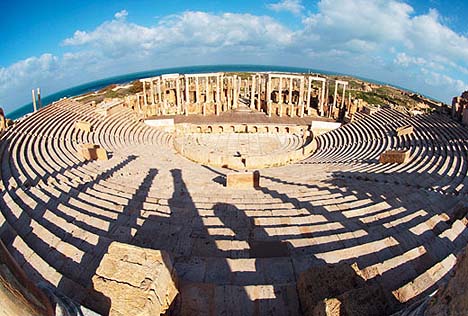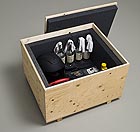
translated and summarized by: Liz Wollner-Grandville,
English summary April 7-13
Neue Galerie am Landesmuseum Joanneum,
Artelier Contemporary – Neuer Showroom:
Michael Schuster
Attention: Trap!
The Galerie Artelier Contemporary recently opened its Neuer Showroom (new showroom) with artwork by Michael Schuster. Among the works are his three-dimensional, colourful typefaces and his premiere presentation of the Graz-variation of “Amerika-Arbeit” with the Kodak Color Control Patch. In his most recent photographs, Schuster utilizes digital methods and thereby consequently continues his primordial artistic approach.
Simultaneously the Neue Galerie is presenting an extensive retrospective of Schuster’s oeuvre, including new or remastered works. The centrepiece of the retrospective is his space-encompassing installation Leptis Magna, a panorama photograph of the antique amphitheatre in the Libyan Desert, taken with a round shot camera.
The artist never makes a secret of the technical appliances or the technologies he used, on the contrary – he conspicuously integrates them into his presentations: strikingly so in “The Hasselblad Room” and the “Autofokusfalle” (auto focus trap). Both of these works have been reprinted using digital photography, thus proving Schuster’s interest in technological feasibility and the abiding actuality of his oeuvre.
Neue Galerie am Landesmuseum Joanneum
8010 Graz, Sackstr.16, until 24.05.08
www.neuegalerie.at
Artelier Contemporary – Neuer Showroom
8010 Graz, Griesgasse 3, until 24. 05.08
www.edition-artelier.at
Wien Museum Karlsplatz: Christian Skrein – Late Sixties
Three days ‘68
He only had three months of training and then worked as a photojournalist for the magazines Stern, Quick, and then even for Vogue at the young age of 18. “It was not that difficult to become a society star in Vienna during the sixties”, Christian Skrein explained. Just like today you had to have sufficient knowledge regarding the insider’s codes of aesthetics, adopt them appropriately, and then mediate them with the right dose of exclusivity. Fashion, art, and pop were his main subjects and his inspiring role model was David Hemmings in Michelangelo Antonioni’s “Blow Up”.
Sean Connery at the Vienna Airport, the Beatles in Obertauern, the Stones performing at Vienna’s event centre Stadthalle – unbelievable how much was going on in Vienna at that time. Hans Hollein furnished posh boutiques, Oswald Wiener, Arnulf Rainer, Hundertwasser in bath robes and Attersee, styled like Jim Morrison, posing to shock the bourgeoisie, while the women in his photographs were mostly beautiful and mainly models.
Skrein’s work, created between 1965 and 1970, depicts a Vienna, which was not as bleak and grey during the post-war years, as it was often described. The exhibit with its reading-lounge and psychedelic ORF (Austrian TV) clips is equally recommendable as the photo book published by the Brandstätter-Verlag “My Way”. The publication amends the exhibit and includes Skrein’s early and experimental works as well as his deadpan commentaries. That’s how cool Vienna was.
Wien Museum Karlsplatz
1040 Wien, Karlsplatz until 11.05.08
www.wienmuseum.at
Medienturm: Helmut Mark – Scultpure
Incitation for complicity
The Kunstverein im Medienturm Graz is currently presenting “Scultpures” by Helmut Mark. Mark, who began his career as a painter, turned to the New Media in the 80s and was actively involved in creating video sculptures and setting up the network platform “thing”. With his current works Mark tackles the role of the observer and makes him to an active accomplice instead of a passive onlooker – as far as this role is accepted by the observer. The self-explanatory title of his sculpture “Do it yourself” makes this incitation obvious: a crate, placed in the middle of a room, as if it had been delivered just a moment ago, contains a female hemp plant, whose growth is stimulated by artificial lighting. Depending on the angle of light the plant could bloom and grow to become cannabis-resin. His other crate-sculpture “Ready made” (2004) attains a significance through the impact of its content - Molotov-cocktails, a black helmet, a gas canister, and many other objects –leaving the classical meaning of “ready-made” far behind. The sculpture “Smoke” (2006) is much less aggressive: the colour of the water in the glass mug changes through the immersed cigarette butts.
Mark’s work is refreshing - his concept does not become an end in itself, but rather the idea, the implementation and the impact, which is aesthetically well thought-out, are appealing to the observer.
Medienturm
8020 Graz, Josefingasse 1, until 26.04.08
www.medienturm.at
Albertina: Max Ernst – Une Semaine de Bonté
The Perfect Crime
The Albertina is currently presenting Max Ernst’s illustrations for the book “Une semaine de bonté” - for the first time in more than 70 years. For many years Max Ernst kept the original collages of this five-volume novel locked up. Werner Spies, the Max Ernst specialist and publisher of the catalogue, points out that Ernst tried to keep the making of theses collages secret: “somewhat comparable to the perfect crime, the collages attempt to evade from any evidence or cogitations regarding scissors or knives.”
The interfaces between the scrapped printed illustrations from the 19th century and the new, absurd, and eerie combinations of the pasted collages had become invisible. Max Ernst was a great expert at this and it is really extremely difficult to detect where the illustrations had been appended.
Max Ernst was a member of Dada Köln and discovered the collage as an artistic form at the beginning of the 20th century. In 1922 he (illegally) arrived in Paris and in 1929 his first collage-novel “La femme 100 tetes” was published. In 1930 he played the bandit chief in Luis Bunuel’s and Salvador Dali’s surrealistic classic movie “L’age d’or” and in the same year published his second collage-novel “Réve d’une petite fille qui voulut entrer au Carmel”. He assembled the 182 collages for his third novel “Une semaine de bonté” during the summer of 1933 during his vacation in Italy. The images in this novel are among the most enigmatic and fascinating manifestations of Surrealism, and they offered all kinds of dramtic scenes such as murder and the appearances of ghosts. He not only intervened subtly into these cliché-like pictures, but also enjoyed to shock the onlooker, by showing a hanged man with a chicken’s head or a postman with dragon’s wings. Max Ernst considered his first movie (1929) “Un chien andalou” as a “desperate appeal for murder”. In comparison to the movie, the ingeniously brutal, gloomy images of the novel with its obliterated interfaces truly come across as the “perfect crime”.
Albertina
1010 Wien, Albertinaplatz 1, until 27. 04.08
www.albertina.at
Mehr Texte von translated and summarized by: Liz Wollner-Grandville


 Teilen
Teilen




